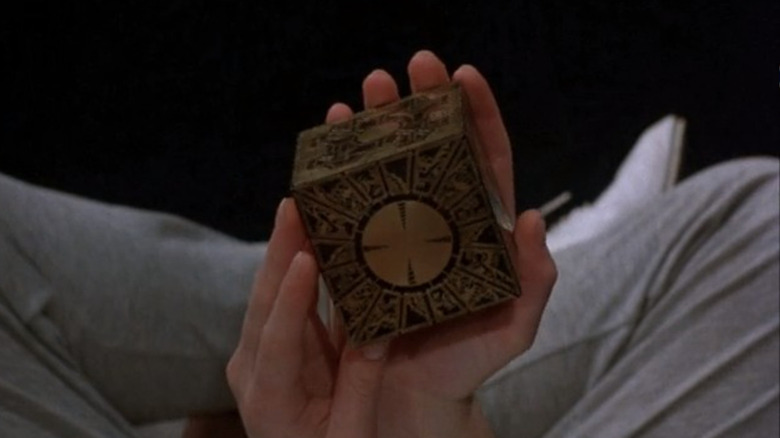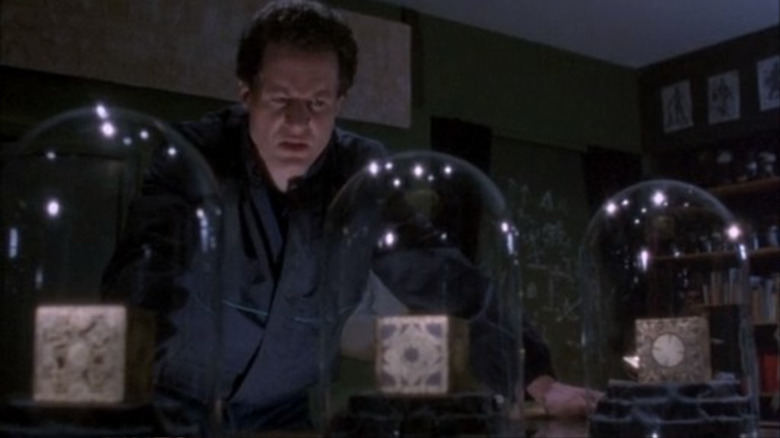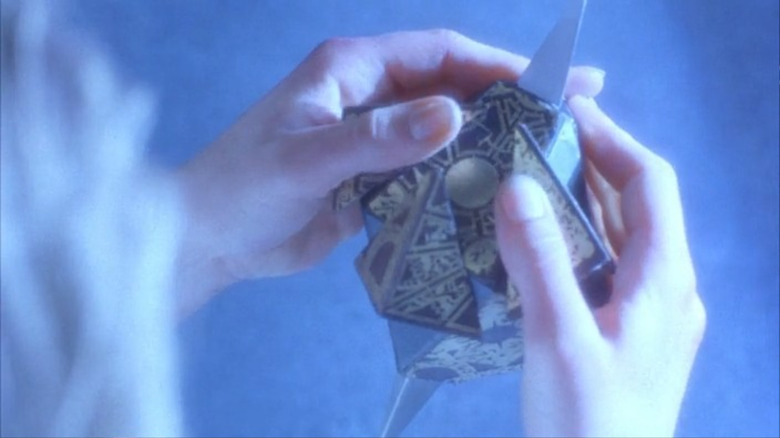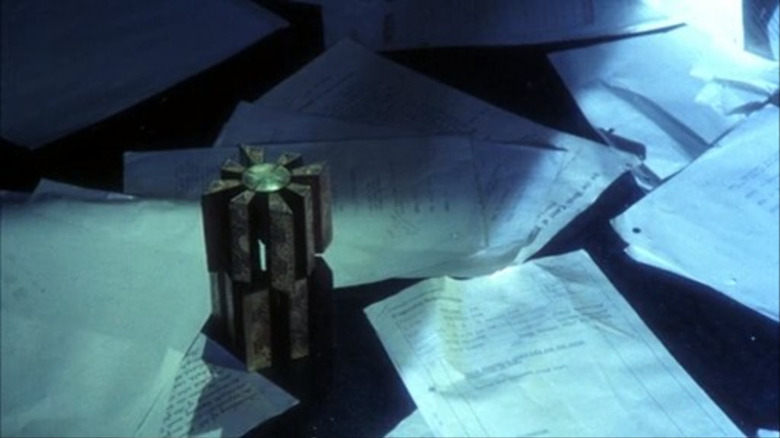Hellraiser: The History And Lore Of The Lament Configuration Explained
The mythology of "Hellraiser" is well known to Clive Barker fans the world over. Certain determined souls, having exhausted the sensual pleasures available to the earthly plane, seek out the Lament Configuration as a means of pushing themselves further. The configuration is a puzzle box that is solved by rotating it just such and sliding one's fingers carefully across a smooth surface. When manipulated correctly, the box slides apart, rotates, and slides back together. When solved, the box ethereally reaches across dimensions to a realm of pure physical experience.
Stepping out of this realm are the Cenobites, supernatural sadomasochists whose own search for the ultimate lustful pleasure has pushed them into a space of constant sensory overload. Their bodies are mutilated with hooks, wires, and nails. They wear black leather outfits that are a cross between S&M fetish wear and a heavy-duty toolbelt. They carry handheld torture devices around their waists. They are perpetually experiencing indivisible pain and pleasure. Having been summoned, the Cenobites physically torture their summoner. The torture is meant to push their victim into the same plane they experience. Those who are ready for such pain may be granted a chance to join the Cenobites in their Hell. Or Heaven, depending on one's viewpoint.
How did the Lament Configuration come to be? What is its history? And how did it become linked with sadomasochists from beyond the grave?
Between Clive Barker's 1986 novella "The Hellbound Heart," eleven feature films, and untold numbers of comic books, the box has had quite an elaborate history and one worth obsessively delving into. An obsession that, incidentally, can also lead one to open the Lament Configuration.
The Hellbound Heart
Here's how the Lament Configuration is described in "The Hellbound Heart":
"The interior surfaces were brilliantly polished. Frank's reflection — distorted, fragmented — skated across the lacquer ... Lemarchand, who had been in his time a maker of singing birds, had constructed the box so that opening it tripped a musical mechanism, which began to tinkle a short rondo of sublime banality."
On the page, the box is pure black and smooth on each side. The tinkling and small bells are also mentioned in Barker's 2015 crossover novel "The Scarlet Gospels" wherein the Lead Cenobite has a face-to-face meeting with Barker's regular paranormal investigator Harry D'Amour, the main character of "Lord of Illusions." In that book, solving the Configuration is accompanied by a mounting sense of exhilaration. In the first two "Hellraiser" feature films, the tinkling interior bells can be heard on the soundtrack. By "Hellraiser III," the bells are more or less gone.
In the films, the box is a dark hardwood that has been laid with three elaborate golden patterns, each repeated twice. There is only one working Lament Configuration. The trio of boxes seen briefly in Tony Randel's 1988 sequel "Hellbound: Hellraiser II" are established in extended canon as fakes. The Cenobites can be forcibly sent back to their realm if the box is solved a second time in their presence. At the very start of Barker's 1987 "Hellraiser," the Lead Cenobite (Doug Bradley), known as Pinhead to most, solves the box himself and returns to his realm with the bloodied remains of Frank.
In "Hellbound" and also the 2022 "Hellraiser," the box can be solved into multiple configurations. In the former, it takes the shape of the chaos god Leviathan. In the latter, it rotates through several shapes, unleashing Cenobites with each change.
Lemarchand
In the 1990s, a series of "Hellraiser" comics explained one origin of the box. It was said that a man named Philip LeMarchand, a prolific serial killer in the 1740s, would steal bones and fat from his victims and work them into his infernal boxes. He was inspired by the real-life saint Albertus Magnus. According to that myth, LeMarchand, also a toymaker, constructed several hundred such puzzles. The puzzles were then infused with black magic by a mysterious Cenobite called the Baron, who linked them to the Hell realm.
This origin was contradicted by Alan Smithee's 1996 film "Hellraiser: Bloodline," the fourth in the series. The first act of that film takes place 1796 and the toymaker with the newly re-spelled name of Philippe Lemarchant (Bruce Ramsay) was hired by a corrupt duke named Duc de L'Isle (Mickey Cottrell) a character who was — according to Paul Kane's 2015 book "The Hellraiser Films and Their Legacy" — modeled after the Marquis de Sade and Gille de Rais. Lemarchant built a puzzle box and delivered it to the duke who used it in an elaborate, bloody sacrifice to summon the forces of Hell. Someone will be skinned before the night is over. During the ritual, a young woman named Angelique (Valentina Vargas) became the vessel for a demon on Earth, the box became a means to open Hell, and the duke's sniveling assistant (Adam Scott) was granted eternal life.
The box will eventually make its way into the concrete foundation of a building in the present — an event depicted at the very end of Anthony Hickox's "Hellraiser III: Hell on Earth" — which will cause the entire edifice to resemble a puzzle box. Its magic, it seems, is quite strong.
The fate of the box
Although called the Lemarchant configuration in both "The Hellbound Heart" and "The Scarlet Gospels," the box is referred to as the Lament Configuration in the scripts of the feature films.
The box seems to be supernaturally protected and is never destroyed or exorcized. At the conclusion of "Hellraiser," the box is rescued from a fire by a dragon skeleton. At the conclusion of "Hellbound," its magic is passed into a surreal, gory statue that rises out of a bloodied mattress. Don't ask. Throughout the many straight-to-video "Hellraiser" sequels, the box always managed to turn up, often randomly. In Gary J. Tunnicliffe's 2018 film "Hellraiser: Judgment," other beings from the Hell realm are searching for a way to lure seekers to them with something new and more exciting than a stodgy, centuries-old puzzle box.
"Bloodline" also features a sequence in the year 2127 wherein a descendant of Lemarchant, now named Merchant (also Ramsay), has figured out a way to build a new puzzle — one that the original Lemarchand designed but was unable to build — that will trap the Cenobites and seal the schism between Hell and Earth once and for all. The new puzzle takes the form of a massive spacecraft. Merchant summons the Cenobites, and then closes the craft around them. Pinhead, for he still leads the cenobites, perishes in the blast. His final word is "amen."
David Brucker's 2022 film "Hellraiser," introduces the box as a means of sacrifice, making it reminiscent of "Friday the 13th: The Series." Those who bleed on the puzzle will be taken away to Hell, and the survivors shall be granted powers in exchange.
In whatever iteration, the box is mysterious, threatening, and leaves blood in its wake.
What's your pleasure?



